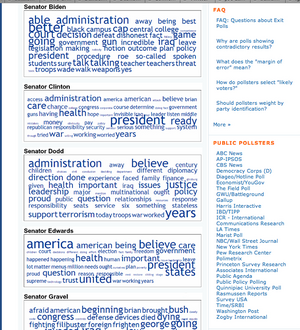For regular readers wondering about the recent quiet here, a notice that Boxes and Arrows will shortly publish an article I’ve been working on for a while in the background, titled, “It Seemed Like the Thing To Do At the Time: The Power of State of Mind”. This is the written version of my panel presentation Lessons From Failure: Or How IAs Learn to Stop Worrying and Love the Bombs from the 2007 IA Summit in Las Vegas.
I’ve written about organizations and failure – Signs of Crisis and Decline In Organizations – in this blog before (a while ago, but still a popular posting), and wanted to consider the subject on a larger level. With the rapid spread of social software / social media and the rise of complex social dynamics in on-line environments, exploring failure at the level of an entire society is timely.
In The Fishbowl
Failed or failing societies are an excellent fishbowl for observers seeking patterns related to social media, for two reasons. First, the high intensity of failure situations reveals much of what is ordinarily hidden in social structures and patterns: Impending collapse leads people to dispense with carefully maintained social constructions.
One source of this heightened intensity is the greatly increased stakes of societal failure (vs. most other kinds), which often means sudden and dramatic disruptions to basic living and economic patterns, the decline of cities and urban concentrations, and dramatic population decrease. Another source is the very broad scope of the aftereffects; because a failing society involves an entire culture, the affects are comprehensive, touching everyone and everything.
Secondly, societies often command substantial qualitative and quantitative resources that can help them manage crisis or challenges, thereby averting failure. Smaller, less sophisticated entities lack the resource base of a complex social organism, and consequently cannot put up as much of a fight.
Examples of resources available at the level of a society include:
- Leaders and planners dedicated to focusing on the future
- Large amounts of accumulated knowledge and experience
- Sophisticated structures for decision making and control
- Mechanisms for maintaining order during crises
- Collective resilience from surviving previous challenges
- Substantial stores of resources such as food and materials, money, land
- Tools, methods, and organizations providing economies of scale, such as banking and commerce networks
- Systems for mobilizing labor for special purposes
- Connections to other societies that could provide assistance (or potential rescue)
Despite these mitigating resources, the historical and archeological records overflow with examples of failed societies. Once we read those records, the question of how these societies defined themselves seems to bear directly on quite a few of the outcomes.
I discuss three societies in the article: Easter Island, Tikopia, and my own small startup company. We have insight into the fate of Easter Island society thanks to a rich archeological record that has been extensively studied, and descriptions of the Rapa Nui society in written records kept by European explorers visiting since 1722. Tikopia of course is still a functioning culture. My startup was a tiny affair that serves as a useful foil because it shows all the mistakes societies make in a compressed span of time, and on a scale that’s easy to examine. The Norse colonies in North America and Greenland are another good example, though space constraints didn’t allow discussion of their failed society in the article.
Read the article to see what happens to all three!
Semi Random Assortment of Quotations
In the meantime, enjoy this sampling of quotations about failure, knowledge, and self, from some well-known – and mostly successful! – people.
“Technological change is like an axe in the hands of a pathological criminal.” – ALBERT EINSTEIN
“It is not the strongest of the species that survives, nor the most intelligent, but the one most responsive to change.” – CHARLES DARWIN
“It is impossible for a man to learn what he thinks he already knows.” – EPICTETUS
“I have not failed. I’ve just found 10,000 ways that won’t work.” – THOMAS EDISON
“It is on our failures that we base a new and different and better success.” – HAVELOCK ELLIS
“Life is a process of becoming, a combination of states we have to go through. Where people fail is that they wish to elect a state and remain in it.” – ANAIS NIN
“We read the world wrong and say that it deceives us.” – RABINDRANATH TAGORE
“Whoever longs to rescue quickly both himself and others should practice the supreme mystery: exchange of self and other.” – SHANTIDEVA
“Failure is instructive. The person who really thinks learns quite as much from his failures as from his successes.” – JOHN DEWEY

